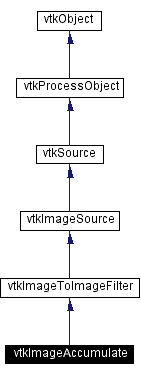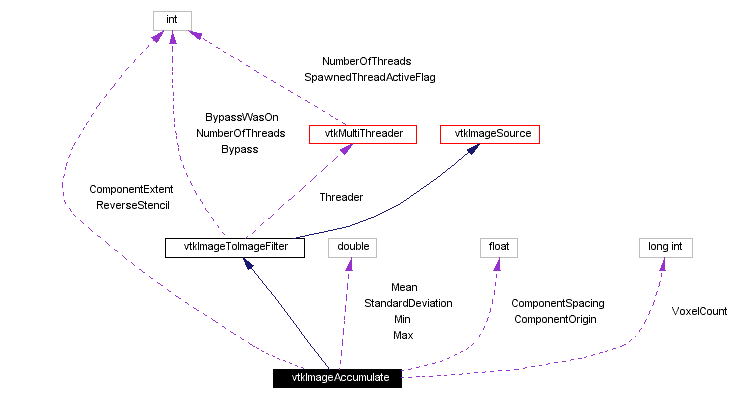
#include <vtkImageAccumulate.h>
Inheritance diagram for vtkImageAccumulate:


Public Methods | |
| virtual const char * | GetClassName () |
| virtual int | IsA (const char *type) |
| void | PrintSelf (ostream &os, vtkIndent indent) |
| virtual void | SetComponentSpacing (float, float, float) |
| virtual void | SetComponentSpacing (float[3]) |
| virtual float * | GetComponentSpacing () |
| virtual void | GetComponentSpacing (float &, float &, float &) |
| virtual void | GetComponentSpacing (float[3]) |
| virtual void | SetComponentOrigin (float, float, float) |
| virtual void | SetComponentOrigin (float[3]) |
| virtual float * | GetComponentOrigin () |
| virtual void | GetComponentOrigin (float &, float &, float &) |
| virtual void | GetComponentOrigin (float[3]) |
| void | SetComponentExtent (int extent[6]) |
| void | SetComponentExtent (int minX, int maxX, int minY, int maxY, int minZ, int maxZ) |
| void | GetComponentExtent (int extent[6]) |
| int * | GetComponentExtent () |
| void | SetStencil (vtkImageStencilData *stencil) |
| vtkImageStencilData * | GetStencil () |
| virtual void | SetReverseStencil (int) |
| virtual void | ReverseStencilOn () |
| virtual void | ReverseStencilOff () |
| virtual int | GetReverseStencil () |
| virtual double * | GetMin () |
| virtual void | GetMin (double &, double &, double &) |
| virtual void | GetMin (double[3]) |
| virtual double * | GetMax () |
| virtual void | GetMax (double &, double &, double &) |
| virtual void | GetMax (double[3]) |
| virtual double * | GetMean () |
| virtual void | GetMean (double &, double &, double &) |
| virtual void | GetMean (double[3]) |
| virtual double * | GetStandardDeviation () |
| virtual void | GetStandardDeviation (double &, double &, double &) |
| virtual void | GetStandardDeviation (double[3]) |
| virtual long int | GetVoxelCount () |
Static Public Methods | |
| vtkImageAccumulate * | New () |
| int | IsTypeOf (const char *type) |
| vtkImageAccumulate * | SafeDownCast (vtkObject *o) |
Protected Methods | |
| vtkImageAccumulate () | |
| ~vtkImageAccumulate () | |
| void | ExecuteInformation (vtkImageData *input, vtkImageData *output) |
| void | ComputeInputUpdateExtent (int inExt[6], int outExt[6]) |
| void | ExecuteInformation () |
| void | ExecuteData (vtkDataObject *out) |
Protected Attributes | |
| float | ComponentSpacing [3] |
| float | ComponentOrigin [3] |
| int | ComponentExtent [6] |
| double | Min [3] |
| double | Max [3] |
| double | Mean [3] |
| double | StandardDeviation [3] |
| long int | VoxelCount |
| int | ReverseStencil |
Definition at line 74 of file vtkImageAccumulate.h.
|
|
|
|
|
|
|
|
Instantiate object with no start, end, or progress methods. Reimplemented from vtkImageToImageFilter. |
|
|
Return the class name as a string. This method is defined in all subclasses of vtkObject with the vtkTypeMacro found in vtkSetGet.h. Reimplemented from vtkImageToImageFilter. |
|
|
Return 1 if this class type is the same type of (or a subclass of) the named class. Returns 0 otherwise. This method works in combination with vtkTypeMacro found in vtkSetGet.h. Reimplemented from vtkImageToImageFilter. |
|
|
Return 1 if this class is the same type of (or a subclass of) the named class. Returns 0 otherwise. This method works in combination with vtkTypeMacro found in vtkSetGet.h. Reimplemented from vtkImageToImageFilter. |
|
|
Will cast the supplied object to vtkObject* is this is a safe operation (i.e., a safe downcast); otherwise NULL is returned. This method is defined in all subclasses of vtkObject with the vtkTypeMacro found in vtkSetGet.h. Reimplemented from vtkImageToImageFilter. |
|
||||||||||||
|
Methods invoked by print to print information about the object including superclasses. Typically not called by the user (use Print() instead) but used in the hierarchical print process to combine the output of several classes. Reimplemented from vtkImageToImageFilter. |
|
||||||||||||||||
|
Set/Get - The component spacing is the dimension of each bin. This ends up being the spacing of the output "image". If the number of input scalar components are less than three, then some of these spacing values are ignored. For a 1D histogram with 10 bins spanning the values 1000 to 2000, this spacing should be set to 100, 0, 0 |
|
|
Set/Get - The component spacing is the dimension of each bin. This ends up being the spacing of the output "image". If the number of input scalar components are less than three, then some of these spacing values are ignored. For a 1D histogram with 10 bins spanning the values 1000 to 2000, this spacing should be set to 100, 0, 0 |
|
|
Set/Get - The component spacing is the dimension of each bin. This ends up being the spacing of the output "image". If the number of input scalar components are less than three, then some of these spacing values are ignored. For a 1D histogram with 10 bins spanning the values 1000 to 2000, this spacing should be set to 100, 0, 0 |
|
||||||||||||||||
|
Set/Get - The component spacing is the dimension of each bin. This ends up being the spacing of the output "image". If the number of input scalar components are less than three, then some of these spacing values are ignored. For a 1D histogram with 10 bins spanning the values 1000 to 2000, this spacing should be set to 100, 0, 0 |
|
|
Set/Get - The component spacing is the dimension of each bin. This ends up being the spacing of the output "image". If the number of input scalar components are less than three, then some of these spacing values are ignored. For a 1D histogram with 10 bins spanning the values 1000 to 2000, this spacing should be set to 100, 0, 0 |
|
||||||||||||||||
|
Set/Get - The component origin is the location of bin (0, 0, 0). Note that if the Component extent does not include the value (0,0,0), then this origin bin will not actually be in the output. The origin of the output ends up being the same as the componenet origin. For a 1D histogram with 10 bins spanning the values 1000 to 2000, this origin should be set to 1000, 0, 0 |
|
|
Set/Get - The component origin is the location of bin (0, 0, 0). Note that if the Component extent does not include the value (0,0,0), then this origin bin will not actually be in the output. The origin of the output ends up being the same as the componenet origin. For a 1D histogram with 10 bins spanning the values 1000 to 2000, this origin should be set to 1000, 0, 0 |
|
|
Set/Get - The component origin is the location of bin (0, 0, 0). Note that if the Component extent does not include the value (0,0,0), then this origin bin will not actually be in the output. The origin of the output ends up being the same as the componenet origin. For a 1D histogram with 10 bins spanning the values 1000 to 2000, this origin should be set to 1000, 0, 0 |
|
||||||||||||||||
|
Set/Get - The component origin is the location of bin (0, 0, 0). Note that if the Component extent does not include the value (0,0,0), then this origin bin will not actually be in the output. The origin of the output ends up being the same as the componenet origin. For a 1D histogram with 10 bins spanning the values 1000 to 2000, this origin should be set to 1000, 0, 0 |
|
|
Set/Get - The component origin is the location of bin (0, 0, 0). Note that if the Component extent does not include the value (0,0,0), then this origin bin will not actually be in the output. The origin of the output ends up being the same as the componenet origin. For a 1D histogram with 10 bins spanning the values 1000 to 2000, this origin should be set to 1000, 0, 0 |
|
|
Set/Get - The component extent sets the number/extent of the bins. For a 1D histogram with 10 bins spanning the values 1000 to 2000, this extent should be set to 0, 9, 0, 0, 0, 0. The extent specifies inclusive min/max values. This implies the the top extent should be set to the number of bins - 1. |
|
||||||||||||||||||||||||||||
|
Set/Get - The component extent sets the number/extent of the bins. For a 1D histogram with 10 bins spanning the values 1000 to 2000, this extent should be set to 0, 9, 0, 0, 0, 0. The extent specifies inclusive min/max values. This implies the the top extent should be set to the number of bins - 1. |
|
|
Set/Get - The component extent sets the number/extent of the bins. For a 1D histogram with 10 bins spanning the values 1000 to 2000, this extent should be set to 0, 9, 0, 0, 0, 0. The extent specifies inclusive min/max values. This implies the the top extent should be set to the number of bins - 1. |
|
|
Set/Get - The component extent sets the number/extent of the bins. For a 1D histogram with 10 bins spanning the values 1000 to 2000, this extent should be set to 0, 9, 0, 0, 0, 0. The extent specifies inclusive min/max values. This implies the the top extent should be set to the number of bins - 1. Definition at line 112 of file vtkImageAccumulate.h. |
|
|
Use a stencil to specify which voxels to accumulate. |
|
|
Use a stencil to specify which voxels to accumulate. |
|
|
Reverse the stencil. |
|
|
Reverse the stencil. |
|
|
Reverse the stencil. |
|
|
Reverse the stencil. |
|
|
Get the statistics information for the data. |
|
||||||||||||||||
|
Get the statistics information for the data. |
|
|
Get the statistics information for the data. |
|
|
Get the statistics information for the data. |
|
||||||||||||||||
|
Get the statistics information for the data. |
|
|
Get the statistics information for the data. |
|
|
Get the statistics information for the data. |
|
||||||||||||||||
|
Get the statistics information for the data. |
|
|
Get the statistics information for the data. |
|
|
Get the statistics information for the data. |
|
||||||||||||||||
|
Get the statistics information for the data. |
|
|
Get the statistics information for the data. |
|
|
Get the statistics information for the data. |
|
||||||||||||
|
Reimplemented from vtkImageToImageFilter. |
|
||||||||||||
|
Reimplemented from vtkImageToImageFilter. |
|
|
Reimplemented from vtkImageToImageFilter. Definition at line 149 of file vtkImageAccumulate.h. |
|
|
Reimplemented from vtkImageToImageFilter. |
|
|
Definition at line 143 of file vtkImageAccumulate.h. |
|
|
Definition at line 144 of file vtkImageAccumulate.h. |
|
|
Definition at line 145 of file vtkImageAccumulate.h. |
|
|
Definition at line 152 of file vtkImageAccumulate.h. |
|
|
Definition at line 153 of file vtkImageAccumulate.h. |
|
|
Definition at line 154 of file vtkImageAccumulate.h. |
|
|
Definition at line 155 of file vtkImageAccumulate.h. |
|
|
Definition at line 156 of file vtkImageAccumulate.h. |
|
|
Definition at line 158 of file vtkImageAccumulate.h. |
 1.2.11.1 written by Dimitri van Heesch,
© 1997-2001
1.2.11.1 written by Dimitri van Heesch,
© 1997-2001